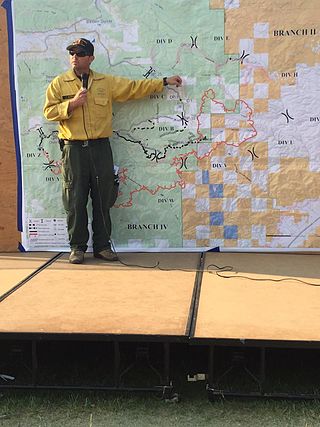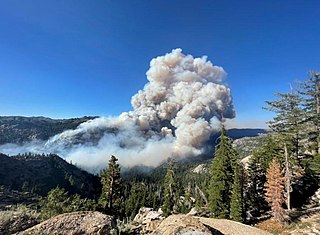
2014 saw several notable wildfires igniting in California, especially during the month of May, when multiple fires were ablaze concurrently in Southern California, and during September, when several massive wildfires were burning in Northern California. In the context of the 2012–13 North American drought, as well as powerful Santa Ana winds, weather conditions were ideal for wildfires. A total of 7,865 wildfires ignited throughout the year, which burned at least 625,540 acres (2,531.5 km2) of land. The wildfires caused a total of 146 injuries and 2 fatalities, in addition to causing at least $204.05 million in damage.

The Lake Fire was a wildfire that burned in the San Bernardino National Forest. The fire started on June 17, 2015, and burned over 31,359 acres before it was fully contained on July 21, 2015.

The North Fire was a wildfire that occurred in the Mojave Desert near the towns of Victorville and Hesperia, north of San Bernardino and south of Bakersfield, California. The fire began on July 17, 2015. The areas most impacted were adjacent to Interstate 15, where the Cajon Pass passes through the San Bernardino National Forest. The fire spread to 4,250 acres, and burned homes and other buildings, as well as numerous vehicles stranded on the interstate. Seventy-four passenger vehicles and trucks were burned along the highway or in neighboring communities due to the fire. The fire closed Interstate 15, the main highway connecting Southern California with Las Vegas, Nevada, during the first day of the blaze.

The October 2007 California wildfires, also known as the Fall 2007 California firestorm, were a series of about thirty wildfires that began igniting across Southern California on October 20. At least 1,500 homes were destroyed and approximately 972,147 acres of land was burned from Santa Barbara County to the U.S.–Mexico border, surpassing the October 2003 California wildfires in scope, which were estimated to have burned 800,000 acres (3,200 km2). The wildfires killed a total of 14 people, with nine of them dying directly from the fires; 160 others were injured, including at least 124 firefighters. At their height, the raging fires were visible from space. These fires included the vast majority of the largest and deadliest wildfires of the 2007 California wildfire season. The only wildfire in 2007 that surpassed any of the individual October 2007 fires in size was the Zaca Fire.

The Border Fire was a large wildfire that burned in Potrero, San Diego County, California, as part of the 2016 California wildfire season. The fire was so named due to its proximity to the United States-Mexican border.

The Blue Cut Fire was a wildfire in the Cajon Pass, northeastern San Gabriel Mountains, and Mojave Desert in San Bernardino County, California. The fire, which began on the Blue Cut hiking trail in the San Bernardino National Forest, was first reported on August 16, 2016 at 10:36 a.m., just west of Interstate 15. A red flag warning was in effect in the area of the fire, with temperatures near 100 °F (38 °C) and winds gusting up to 30 miles per hour (48 km/h).

The Manzanita Fire was a wildfire that burned south of the towns of Beaumont and Banning near Highway 79 in Riverside County, California during June 2017. The fire had consumed some 6,309 acres (2,553 ha) and was burning eastward towards the community of Poppet Flats and Highway 243. Fanned by Red Flag conditions, the Manzanita fire ignited from a traffic collision that grew to over 1,200 acres (490 ha) within several hours of burning. The communities of Poppet Flats, Silent Valley and Highland Springs were threatened for a time but no structural damage occurred during this incident. The fire was fully contained on Friday, June 30.
The Winters Fire was a wildfire that started on Thursday, July 6, 2017 in the Vaca Mountains, near Lake Berryessa west of the city of Winters, in Yolo County, northern California. The fire was named the Winters incident due to its proximity to the city.

The La Tuna Fire was a wildfire in the Verdugo Mountains in Los Angeles County, Southern California, in September 2017. The fire began from undetermined causes on the afternoon of September 1 in La Tuna Canyon, and burned 7,194 acres (2,911 ha) before its containment on September 9. The fire caused at least ten injuries, the destruction of five homes and five outbuildings, and the evacuations of hundreds more. It was one of the largest wildfires in the history of the city of Los Angeles.

A series of 29 wildfires ignited across Southern California in December 2017. Six of the fires became significant wildfires, and led to widespread evacuations and property losses. The wildfires burned over 307,900 acres (1,246 km2), and caused traffic disruptions, school closures, hazardous air conditions, and power outages; over 230,000 people were forced to evacuate. The largest of the wildfires was the Thomas Fire, which grew to 281,893 acres (1,140.78 km2), and became the largest wildfire in modern California history, until it was surpassed by the Ranch Fire in the Mendocino Complex, in the following year.

The Lilac Fire was a fire that burned in northern San Diego County, California, United States, and the second-costliest one of multiple wildfires that erupted in Southern California in December 2017. The fire was first reported on December 7, 2017, burned 4,100 acres (1,659 ha), and destroyed 157 structures, before it was fully contained on December 16. The fire cost at least $8.9 million, including $5 million in firefighting expenses and property damage, and an additional $3.9 million in cleanup and erosion control costs. The fire threatened the communities of Bonsall, Oceanside, Vista, Fallbrook, and Camp Pendleton. During the fire, an estimated 10,000 residents were forced to evacuate, while a total of over 100,000 residents were forced to or advised to evacuate. On December 7, the Lilac Fire also cut the power to 20,000 people.

The Pawnee Fire was a large wildfire that burned in Spring Valley in Lake County, California, in the United States. The fire started on June 23, 2018, and quickly expanded overnight, destroying 12 structures, and causing the evacuation of the entire Spring Valley area. It destroyed 22 structures, damaged six structures, and burned a total of 15,185 acres (61 km2) before it was fully contained on July 8, 2018. A Cal Fire investigation determined in April 2019 the cause of the fire was target shooting.

The Valley Fire was a wildfire that burned near the community of Forest Falls in San Bernardino National Forest, including the San Gorgonio Wilderness in California, United States. The fire was reported on July 6, one of a handful of brush fires that started in the area due to high temperatures and dry conditions. The Valley Fire burned 1,350 acres (5 km2) before it was fully contained on October 22. The fire impacted traffic on Highway 38 due to road closures and has caused evacuations of Forest Falls.
The Soledad Fire was a wildfire that burned 1,525 acres (617 ha) south of Agua Dulce and northeast of Santa Clarita in Los Angeles County, California in the United States during the 2020 California wildfire season. The fire started on July 5, 2020, and caused the complete closure of State Route 14 in both directions throughout the day as the fire grew to 1,498 acres. The fire also at a point threatened over 4,795 structures, although only 9 homes were formally threatened by the direct fireline. The cause of the fire is currently under investigation.

The Apple Fire was a wildfire that burned during the 2020 California wildfire season in Cherry Valley south of Oak Glen and north of Beaumont and Banning in Riverside County, California in the United States. The fire ignited on Friday, July 31, 2020 as three separate smaller blazes within the rural canyons along Oak Glen Road before merging and rapidly expanded to 1,900 acres (769 ha) and destroyed at least one home and two outbuildings in the Cherry Valley area. It now covers at least 33,424 acres (13,526 ha) and created "a plume of smoke so massive that it generated its own winds." The fire was sparked by a diesel-burning vehicle that emitted burning carbon. The fire was named after one of the roadways close to the ignition site, which is named Apple Tree Lane.

The El Dorado Fire was a wildfire that burned 22,744 acres in San Bernardino and Riverside counties of California from September to November 2020. It was ignited on September 5 by a pyrotechnic device at a gender reveal party in El Dorado Ranch Park; it quickly spread to the San Gorgonio Wilderness Area of the San Bernardino National Forest. Burning over a 71-day period, the fire destroyed 20 structures and resulted in one firefighter fatality, for which the couple hosting the party were charged with involuntary manslaughter.

The Tamarack Fire was a wildfire that burned 68,637 acres (27,776 ha), primarily in the Mokelumne Wilderness in Alpine County, California, Douglas County, Nevada and Lyon County, Nevada, as part of the 2021 California wildfire season.
The French Fire was a wildfire that burned 26,535 acres (10,738 ha) near Shirley Meadows west of Lake Isabella in Kern County, California in the United States during the 2021 California wildfire season. The fire was initially reported on Wednesday, August 18, 2021, and ended around October 24, 2021. The fire threatened the communities of Shirley Meadows, Alta Sierra and Wofford Heights. The fire reportedly destroyed some 18 structures, including 9 residences. The fire was determined, as of September 13, 2021, to have been human-caused and suspicious in nature.

The Border 32 Fire was a destructive wildfire that burned amid the 2022 California wildfire season, in the Barrett Junction area along Highway 94 due north of the United States-Mexican border in San Diego County, California during a statewide heatwave. The fire started on August 31, 2022, and proceeded to destroy ten structures and eventually grow to 4,456 acres (1,803 ha) within the rugged chaparral-dense hillsides throughout the area.

The Bridge Fire is an active wildfire in the Angeles National Forest, currently burning in Southern California's Los Angeles and San Bernardino counties. The fire began on September 8. As of September 19, 2024, the fire has burned 54,795 acres and is 53 percent contained. The cause of the fire is under investigation. It is the third-largest wildfire of California's 2024 fire season. It is the largest active wildfire in California and 4,409 structures are still threatened by the fire.

















